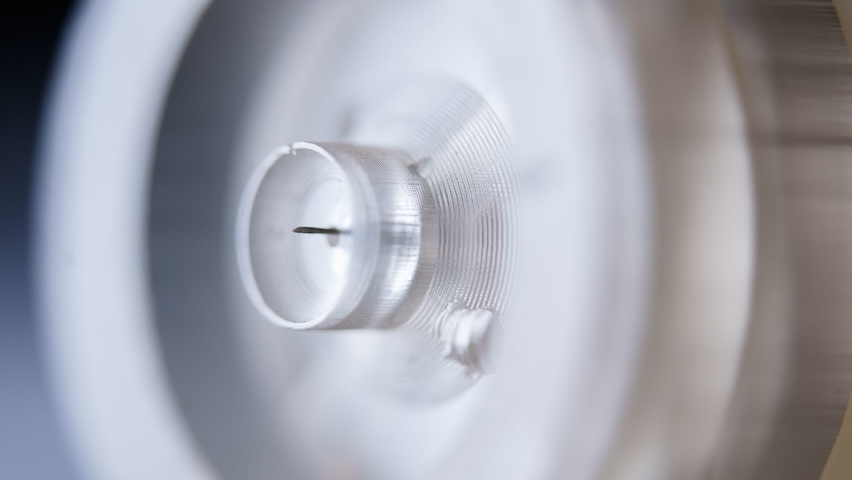Interstitial Fluid Extraction Made Possible with Microneedles
Interstitial Fluid Extraction Made Possible with Microneedles


Researchers have found a way to increase the amount of interstitial fluid extracted with microneedles, which could help diagnose a range of illnesses and conditions.
A microneedle offers a minimally invasive method for sampling interstitial fluid, which lies just beneath the skin. This fluid has many properties in common with blood, yet there remains a lot to discover about its characteristics and potential uses. Sandia National Laboratories is at the vanguard of microneedle research and is partnering with other firms to advance the technology.
Microneedles, at just two to three times the width of a human hair and about a millimeter in length, have a substantial impact. They are revolutionizing health monitoring and early infection diagnosis, particularly benefiting U.S. service members in the field.
One of the collaborative projects between Sandia and SRI, an independent nonprofit research institute, has made advancements in the extraction of interstitial fluid. Initially, the extraction process was inconsistent and time-consuming, requiring one to two hours and multiple arrays of needles to collect sufficient fluid for analysis. However, improvements have led to a more efficient method using a single microneedle, which now gathers enough fluid for a test in approximately 10 minutes. This technique is not only faster but also yields higher volumes of fluid.
Design advances
The design of the microneedles, which penetrate only the outer skin layer without reaching nerve endings, includes hollow centers for fluid extraction. Engineers at Sandia’s Advanced Materials Laboratory have enhanced this technique by modifying the shape of the needle holders, which are produced using 3D printing.
According to Adam Bolotsky, a Sandia engineer, the design process also considers engineering and comfort, aiming to optimize the depth of penetration for maximal fluid collection with minimal discomfort. Continuous feedback from participants has been integral to refining the microneedles’ design to achieve the best balance between efficiency and user comfort.
Discover the Benefits of ASME Membership
“SRI and Sandia are collaborating on a DTRA funded project called PatchDx to make a wearable sensor that can distinguish between bacterial and viral infections,” explained Ronen Polsky, principal member of technical staff in the Biological and Chemical Sensors Department at Sandia. “Through the course of this project, previously developed Sandia technology for dermal interstitial fluid extraction was significantly improved, increasing the volumes of interstitial fluid extracted and decreasing the time necessary to perform the extractions. Dynamic changes of several host-response biomarkers in interstitial fluid have been identified that relate to infections and will be used to guide sensor development.”
More applications
“Interstitial fluid holds great promise as a novel biofluid for diagnostic applications but has remained somewhat elusive due to the great difficulty in acquiring interstitial fluid samples for analysis,” Polsky said. “The improvements made on the ability to extract interstitial fluid allow for further biodiscovery experiments to explore diagnostic utility of interstitial fluid and expand clinical trials to research disease specific conditions.”
With more efficient fluid collection, researchers can recruit larger cohorts for studies in less time, further opening the possibilities for other uses. One emerging application involves utilizing microneedles to differentiate between bacterial and viral infections, a collaborative effort between Sandia and SRI. This distinction could significantly aid doctors in making faster, more accurate treatment decisions, crucial for initiating timely interventions.
The project, funded by the Defense Threat Reduction Agency, aims to develop a device capable of continuous health monitoring through interstitial fluid. While promising, this innovation requires further development before it can seek FDA approval.
Editor's Choice: Self-Steering Robotic Needle for More Accurate Lung Biopsies
Sandia is also collaborating with Adaptyx Biosciences under a Cooperative Research and Development Agreement to enhance the understanding of biomarkers in interstitial fluid. Adaptyx aims to investigate the components of interstitial fluid and their correlation to blood measurements, utilizing Sandia’s technology for foundational physiological studies.
As part of their joint efforts, Sandia is streamlining the collection of interstitial fluid from volunteers using an efficient method that requires only 15 minutes of their time, significantly easing the recruitment process. The fluid is then analyzed by Adaptyx, which is working towards developing devices for continuous health monitoring for widespread public use.
In addition to its work with SRA and Adaptyx, Sandia has teamed up with the University of California, Berkeley, to develop microneedle sensors that detect electrolytes like sodium, potassium, and calcium. This three-year project, now in its second year, aims to create devices for continuous electrolyte monitoring. Like wearable glucose meters, these sensors could aid in managing cardiovascular functions, hydration levels, and electrolyte imbalances across various health conditions.
Jim Romeo is a technology writer in Chesapeake, Va.





